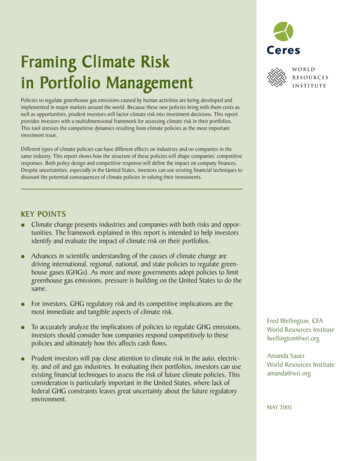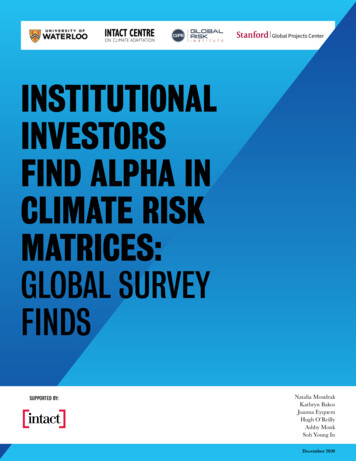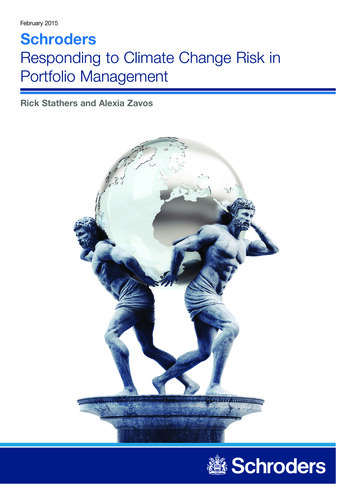
Transcription
Framing Climate Riskin PPortfolioortfolio s to regulate greenhouse gas emissions caused by human activities are being developed andimplemented in major markets around the world. Because these new policies bring with them costs aswell as opportunities, prudent investors will factor climate risk into investment decisions. This reportprovides investors with a multidimensional framework for assessing climate risk in their portfolios.This tool stresses the competitive dynamics resulting from climate policies as the most importantinvestment issue.Different types of climate policies can have different effects on industries and on companies in thesame industry. This report shows how the structure of these policies will shape companies’ competitiveresponses. Both policy design and competitive response will define the impact on company finances.Despite uncertainties, especially in the United States, investors can use existing financial techniques todiscount the potential consequences of climate policies in valuing their investments.KEY POINTS Climate change presents industries and companies with both risks and opportunities. The framework explained in this report is intended to help investorsidentify and evaluate the impact of climate risk on their portfolios. Advances in scientific understanding of the causes of climate change aredriving international, regional, national, and state policies to regulate greenhouse gases (GHGs). As more and more governments adopt policies to limitgreenhouse gas emissions, pressure is building on the United States to do thesame. For investors, GHG regulatory risk and its competitive implications are themost immediate and tangible aspects of climate risk. To accurately analyze the implications of policies to regulate GHG emissions,investors should consider how companies respond competitively to thesepolicies and ultimately how this affects cash flows. Prudent investors will pay close attention to climate risk in the auto, electricity, and oil and gas industries. In evaluating their portfolios, investors can useexisting financial techniques to assess the risk of future climate policies. Thisconsideration is particularly important in the United States, where lack offederal GHG constraints leaves great uncertainty about the future regulatoryenvironment.Fred Wellington, CFAWorld Resources Institutefwellington@wri.orgAmanda SauerWorld Resources Instituteamanda@wri.orgMAY 2005
ACKNOWLEDGEMENTSThis report has benefited immensely from the input offinancial and environmental experts. Ceres and WRI extendtheir thanks to Mike Johnston and Brigette Pearson fromThe Capital Group Companies, Meredith Miller andDonald Kirshbaum from the Office of the Treasurer of theState of Connecticut and Duncan Austin from GenerationInvestment Management for reviewing and commenting onthis report. We are particularly grateful to Ceres SeniorAdvisor David Gardiner, President of David Gardiner &Associates for his insight and advice in preparing thisreport. David Jhirad, Liz Cook, Andrew Aulisi, RobBradley, and Nick Powers from WRI provided usefulcomments. Tim Brennan, Chris Fox, Jim Coburn andPeyton Fleming of Ceres also offered valuable assistance.We would like to thank the Better World Fund for itsgenerous support of the Investor Network on Climate RiskResearch Consortium. The Energy Foundation and thePew Charitable Trusts also provided critical funding toCeres for this work. WRI would like to thank the SurdnaFoundation, The SC Johnson Foundation and the OakFoundation for their generous financial support.The authors alone are responsible for the views andperspectives expressed in this publication.
3FRAMING CLIMATE CHANGE RISK IN PORTFOLIO MANAGEMENTA FRAMEWORK FOR CLIMATE RISKCLIMATEANALYSISANALYSISInstitutional investors—and the companies in which theyinvest—try to invest capital in a way that minimizes risk andmaximizes return. In security markets, nearly all portfolioinvestments are based on portfolio theory, which is founded onthe premise that investing in diversified assets reduces riskacross a portfolio while maintaining a given level of expectedreturn.1 In other words, a successful portfolio combinesinvestments in different industries to maximize returns whileminimizing risk. Box 1 explains the difference between risk anduncertainty.Diversification of investments means that asset returns will notdepend on the same economic variables and will therefore notmove in parallel under the same economic conditions.2 Forexample, shares of home building companies usually move inthe opposite direction of interest rates.In reality, a truly diversified portfolio is almost impossiblebecause most assets depend on similar economic conditionssuch as consumer spending or interest rates and, to someextent, move in the same direction as the entire economy. Inportfolio theory, this aspect of risk, called “systematic risk,” (ormarket risk), cannot be diversified away. Risk that is particularto a specific industry or company, called “unsystematic risk,”can be eliminated through diversification. However, traditionaldefinitions of financial risk should be expanded to reflectemerging issues that will affect individual sectors or companies.Investors can use a portfolio theory to begin to assess howclimate change can affect investments.Box 1. Risk vversusersus UncertaintyInvestors looking at the financial effects of climate policy mustdifferentiate between risk and uncertainty. In the context ofinvestment analysis, risk can be considered as a mathematicaldistribution of potential outcomes around known parameters,even if the actual parameters and shape of the distribution isin dispute. Uncertainty, on the other hand, involves a lack ofinformation for determining the parameters with which toassess investment risk.aUncertainty on climate change is related mainly to the policyframework under which greenhouse gases will be regulated.bWithout certainty on climate policy, its financial and competitive implications cannot be accurately assessed. In otherwords, uncertainty is the absence of reliable information onthe future structure of a climate regulatory framework. Risk, onthe other hand, is related to the individual company’scompetitive response to the chosen policy environment. Putanother way, uncertainty is related to the policy frameworkwhile risk is related to the consequences of the chosen policy.For example, in Europe climate regulatory risk can be analyzedbecause the parameters around policy are generally known.However, in the U.S. not only is the likely future structure ofpolicy not known, but competitive responses by companies tothese polices are difficult to estimate.a. A substantial body of economic research is available on this topic.The foundation was established in Frank Knight’s book, Risk,Uncertainty and Profit. (Boston, Mass,: Houghton, MifflinCompany, 1921).b. The extent of physical climate risk is also uncertain. This reportacknowledges that climate risk contains a physical component butfocuses on the uncertainty surrounding the policy response tocontrol GHG emissions.Climate Risk PPosesoses Both Systematic andUnsystematic Risk to PPortfoliosortfoliosUsing portfolio theory, climate risk can be broken down into twoconstituent components that together make up a portfolio’s totalclimate risk exposure, systematic risk and unsystematic risk.Systematic risk is associated with macro concerns such asoverall economic and market risk. Climate change, and policiesto combat its impacts, will create systematic risk across theentire economy, affecting energy prices, national income,health, and agriculture. As a systematic risk, it will disproportionately affect energy production and consumption. Moreresearch and sophisticated modeling will be necessary toquantify how systematic climate risk will be distributedthroughout the economy. Although climate risk has a systematicelement, this paper explores issues around unsystematic climaterisk and its implications for portfolio management.Unsystematic climate risk (including both issuer and sector riskin this context) is the component of investment risk particular toa specific security. With respect to issuer risk, for instance,returns on equity investments are determined by a company’sunderlying financial performance on earnings, profitability, andreturn on invested capital. A company’s financial performance is,in turn, influenced by competitive positioning around issuesaffecting the industry as a whole. Sector risk affects all companiesin a given sector, for example due to potential regulations, classaction lawsuits, or shifts in demand. Figure 1 illustrates howunsystematic climate risk can be deconstructed into sectorspecific and company-specific risk.This FFramewramework Can Be Used to AnalyzerameworkClimate Risk across a PPortfolioortfolioacrossThe key question for investors considering the implications ofclimate risk is: “Under what circumstances might climatechange affect my portfolio—and to what degree?”3 To answerthat question, investors must consider:Ceres and WRI
4FRAMING CLIMATE CHANGE RISK IN PORTFOLIO MANAGEMENTFiguralueiguree 1. How Climate ChangChangee Influences Corporate VValueSource: WRI Capital Markets Research. By what mechanisms might climate risk affect company andportfolio performance? What financial and competitive repercussions might eachmechanism have?Investors can begin to investigate the first question using theframework sketched in Figure 1. Yet, a company’s competitivepositioning in response to climate policies will reflect forinvestors the most immediate and tangible aspect of acompany’s exposure to climate risk. Therefore, to answer thesecond question, investors will need information about thestructure of climate policy.Each mechanism of climate risk presents investors with differentanalytical problems. Overlooking the financial consequences ofthese mechanisms could lead to an insufficient assessment ofrisk in some companies. This framework and the rest of thispaper deal exclusively with how to assess the risk climatechange poses to investments.There are two types of climate-related risk: Ceres and WRISector-Specific RiskSector-specific risk consists of regulatory risk and physical risk.Regulatory risk. International, national, regional, and stateregulation of greenhouse gases (GHGs),4 depending on thestringency, is likely to have a financially material effect on mostGHG-intensive sectors, because it will create a cost for carbondioxide (CO2) and other GHG emissions.Physical risk. Some sectors of the economy will be directlyaffected by the physical effects of climate change such asdroughts, floods, storms, and rising sea levels. Agriculture,fisheries, forestry, health care, insurance, real estate, tourism,and water may be particularly exposed because of theirdependence on the physical environment, human health, water,and weather—all directly affected by climate change. Thecompetitive implications of physical climate risk will be feltover a longer timeframe. Precisely how this risk will manifestitself throughout the economy is uncertain, but some sectorswill benefit while others could face difficulties.Sector-specific risk, the risk posed to all companies in asector or industry.Company-Specific RiskCompany specific risk, the risk posed to specific companiesin a sector or industry.Company-specific risk encompasses competitive risk, litigationrisk, and reputational risk.
5FRAMING CLIMATE CHANGE RISK IN PORTFOLIO MANAGEMENTCompetitivCompetitivee risk. Within any climate regulatory framework, somecompanies will fare better than others. Individual companies couldwin or lose depending on the policy framework. In portfoliomanagement, this dynamic is most important in determining theeffects of GHG constraints on investment valuation.Litigation risk. High GHG-emitting companies could face riskLitigationin the form of lawsuits similar to those in the tobacco, pharmaceutical, and asbestos industries. For instance, in an initiativeled by New York Attorney General Eliot Spitzer, eight statesand New York City have filed an unprecedented lawsuit againstfive of America’s largest power companies, demanding that theycut CO2 emissions.5 At this time, the prospect of climatechange lawsuits is hard to factor into the valuation of individualcorporations, and it is unlikely that any financial impacts will befelt in the near term.Reputational risk. Companies viewed negatively with respect toclimate change (for their politics, products, or processes) couldrun into consumer or shareholder backlash in environmentallysensitive markets. This is especially relevant in highly competitive sectors such as automobiles and fuel service stations wherebrand loyalty is an important attribute of company value. Aswith other reputational issues, costs or benefits are difficult toproject accurately into security valuations.Companies will be exposed to different aspects of climate riskdepending on the sector and the geographic location of theiroperations. Broadly speaking, however, investors should firstassess sector-specific climate risk in their portfolios. Forexample, energy-intensive industries will be affected by GHGregulations more than, say, technology or pharmaceuticalcompanies, while agriculture will be more sensitive to thephysical effects of climate change. Yet, investors should paymore attention to the emerging competitve dynamics that arecreated by climate policies.Investors Should FFocusocus on the CompetitivInvestorsCompetitiveeImplications of Climate PPoliciesoliciesClimate policies are increasingly likely to have a financialimpact (positive or negative) on many sectors. Although asector-level analysis of climate risk is important, the moresignificant analytical process is to determine a company’sstrategy around climate policies in order to choose companieswith limited risk exposure and better competitive positioning.Because no two companies will be affected the same way byclimate policies, investors should concentrate on competitiveness, which provides an opportunity to separate climate winnersfrom climate losers. The proximity and materiality of climateregulations for a number of sectors make this the appropriateanalytical path to rebalance portfolios or take other steps tomitigate climate risk. In time, though, and with more information, investors will also need to quantify the impacts of othermechanisms by which climate risk will affect their investments.CLIMATE POLICIES AROUNDCLIMATEAROUNDTHE WORLD ARE GAININGMOMENTUMMomentum has been gathering for the enactment of policies toregulate GHGs. Regardless of where they do business, it will beincreasingly difficult for companies in GHG-intensive sectors toescape GHG policies and regulations. The structure andgeographical overlap of these policies is what will shape climatecompetitveness.Companies in GHG-intensive sectors will be subject toregulations and standards in the European Union (EU), Canada,Japan, Australia, Russia, and some U.S. regional markets. Also,regulations on fuel economy and CO2 emissions in the automotive sector in these markets (and China)6 will affect the financesof auto companies operating there.The EU has moved aggressively to reduce GHG emissions. Itadopted the Kyoto Protocol in 2002 (Box 2) and started theEmission Trading Scheme (ETS) in 2005, setting CO2 emissionlimits for companies in the cement, oil refining, power, pulpand paper, and steel industries.7 These policies will influencecompetitiveness and valuations in these sectors. Already in1998, the EU struck a voluntary agreement with automobilemanufacturers to reduce CO2 emissions on new passenger carsby 25 percent by 2008 (and possibly by an additional 10percent by 2012).8 The European Commission has stated that itwill regulate the industry if it fails to meet these standards.Thus, the European automobile sector will also experienceclimate competitiveness issues going forward.Canada, like the EU, has committed to the Kyoto Protocol andis obligated to reduce its GHG emissions as prescribed by thetreaty. For large final emitters, the Climate Change Plan forCanada establishes a three-prong approach on reductiontargets, emissions trading, and technology standards.9 Thegovernment has also reached an agreement with the automobileindustry to reduce CO2 emissions from new vehicles by 25percent by 2010.10Japan has also ratified the Kyoto Protocol and has designed animplementation plan requiring GHG-reduction targets for majoreconomic sectors. This plan includes an increase in fueleconomy standards for passenger vehicles, new standards forcommercial vehicles and aircraft, tax incentives for lowemission vehicle technologies, and overall energy efficiencyimprovements in the economy.In Australia, despite the federal government’s rejection of theKyoto Protocol, state and territory leaders agreed in March2005 to establish their own interstate GHG emissions tradingsystem. Details of this system are still unclear.Russia ratified the Kyoto Protocol in November 2004. However,because industrial production has dropped since 1990 (Kyoto’sCeres and WRI
6FRAMING CLIMATE CHANGE RISK IN PORTFOLIO MANAGEMENTBox 2. The Kyoto ProtocolProtocolIn 1992, the United Nations Framework Convention on ClimateChange (UNFCCC) began to negotiate a global treaty toreduce GHG emissions contributing to climate change. Thisprocess resulted in the Kyoto Protocol, which was adopted atthe Convention’s third meeting in 1997 in Kyoto, Japan. TheKyoto Protocol requires that at least 55 percent of industrialcountries’ CO2 emissions are included under the treaty beforeit enters into force. As of May, 2005, 149 nations have ratifiedthe treaty, including developed countries responsible for over6o percent of global CO2 emissions. The Protocol went intoeffect on February 16, 2005.base year), Russia will likely have a surplus of emissionallowances to sell under the treaty.The United States—unlike the EU, Canada, Japan, andRussia—has made no binding national commitments to reduceGHG emissions. However, as outlined in Box 3, several U.S.states have implemented or are studying climate policies. Theseregulations demonstrate a significant commitment to reducingGHG emissions on the part of state and local governments.Over time, the interstate regulatory burden may add momentumto growing pressures for U.S. action at the federal level.11 This,coupled with a significant policy discrepancy with most of theindustrial world could eventually lead the United States toreengage in global climate negotiations.Indeed, leading U.S. companies facing potential climateregulations now say that GHG constraints are inevitable. Forexample, American Electric Power (AEP), the nation’s largestelectricity producer and source of CO2 emissions has issued aspecial report to shareholders analyzing its exposure to GHGregulations. The report concludes that “ mandatory carbonconstraints in the long-term appear probable” and “ initialmandatory reductions of greenhouse gas emissions are likely inthe next decade.”12 In a similar report to shareholders, Cinergystated that it eventually will operate its business in a carbonconstrained world.Just how U.S. climate policy will evolve is still unclear, despitethe trend around the world toward regulating GHG emissions.As electric power company TXU states in a recent report toshareholders on climate change, mandatory CO2 controls onelectric generators in the US are inevitable at some point, yetthere is little agreement on the timing and the nature.13Prudent investors will move beyond asking whether some formof climate policy is on the U.S. horizon, to considering whenand in what form.Ceres and WRIThe extent to which climate policies affect companies dependsgreatly on the design, stringency, and timing of these regulations.New climate policies will change cost structures, create newmarkets and product opportunities, affect competition, and alterdemand patterns. The financial implications of these policiescannot be accurately determined without knowing how companies are positioned around these new competitive parameters.Box 4 outlines major policy options that have been used inclimate policies around the world. Each option will havedifferent implications for the way companies can respond tomeet the regulations. For example, specific emissions limits oraveraging mechanisms such as the Corporate Average FuelEconomy (CAFE) program in the United States are less flexiblefor manufacturers than an emissions trading program.Although forecasting the exact financial implications of climatepolicies is difficult, industries that are a significant source ofGHG emissions (directly or indirectly) will likely see a morepronounced impact than those that are not heavy emitters.GHG-intensive industries are also more exposed to U.S. policyuncertainty, which may increase the perceived risk associatedwith earnings streams in those industries. In addition, climatepolicies could create opportunities for some sectors (e.g.,renewable energy and clean technology companies) that may beable to offer solution products and exploit rapidly expandingmarket opportunities. Moreover, the overlap of climate policyregimes within global markets will create an important set ofcompetitive issues for multinational companies.The StructuroliciesStructuree of Climate PPoliciesInfluences the FFinancialinancial and CompetitivCompetitiveeImpacts on CompaniesAssessing climate policy risk goes beyond simply determiningwhich companies will or will not be regulated. Climate policiescould affect different sectors in varying forms and over distincttimeframes. For instance, the power sector is likely, sooner orlater, to face limits on GHG emissions and thus reflect thesecosts in electricity prices. Other large point emitters and thetransport sector will either have GHG emissions capped (as inthe EU) or be subject to technical standards (or possibly both).Indeed, climate policies have various elements that areimportant to estimating competitive impacts for companies heldin a portfolio. These include the following: The actual mix and design of various policy options includingtaxes, emissions trading programs or standards.14 This canhave significant impacts at the sector and company level. The relative stringency of the chosen policy design and mix. The sectors that will be regulated.
7FRAMING CLIMATE CHANGE RISK IN PORTFOLIO MANAGEMENTBox 3. U.S. State Climate RegulationsIn the United States, state governments have taken the lead inregulating greenhouse gases (GHGs). As under differentinternational regulatory plans, companies operating in states withclimate-related regulations may face increased climate risk orcompetitive advantage compared to companies that do not operatein these states. It will be important for investors to find out howthese state policies affect the financial performance of companiesin their portfolio. Key state actions include:California, in 2003, adopted legislation directing the CaliforniaAir Resources Board (CARB) to achieve the maximum feasible andcost-effective reduction of greenhouse gases from California’smotor vehicles. CARB has proposed a rule that would reduceemissions approximately 30 percent. The standard will take effectwith 2009 model-year automobiles.Maine, Massachusetts, New York, and Vermont have similar autostandards to California. Connecticut, Oregon, New Jersey, RhodeIsland, and Washington state have announced that they also intendto follow them as well. Together with California, consumers inthese states buy about 25 percent of all cars sold in the UnitedStates.All of the Northeast and Mid-Atlantic states are studying orimplementing programs to reduce GHG emissions. For example,in April 2000, New Jersey adopted a statewide goal of reducingGHG emissions to 3.5 percent below 1990 levels by 2005.Similarly, the New England governors and the Eastern Canadianpremiers issued a Climate Change Action Plan in August 2001,calling for the reduction of GHGs to 10 percent below 1990 levelsby 2020. New York’s State Energy Plan calls for the reduction ofthe state’s CO2 emissions to 5 percent below 1990 levels by 2010and to 10 percent below those levels by 2020. In April 2001,Massachusetts established a rule requiring designated powerplants to reduce CO2 emissions by 10 percent from 1997–1999 The actual implementation of the chosen policy design. Forinstance, in emissions trading systems, direct allocation ofallowances by governments may have different implicationsfrom “auctioning” allowances.15 The timing of climate policy and regulatory action. The extent to which regulatory structures in other jurisdictionswill be coordinated. This aspect of uncertainty is perhaps themost problematic because multinationals compete in anincreasing number of jurisdictions that regulate GHGs.All these considerations should enter into a prudent investor’sanalysis of climate policy risk across a portfolio. Judging by thealready widespread use of emissions trading systems, futureclimate policies in the United States and elsewhere will allowemissions trading in some capacity to regulate emissions fromlevels. Plants must meet the deadline by 2006, unless undertakinga fuel shift, in which case they may delay until October 2008. InMay 2002, New Hampshire adopted limits on CO2 emissions frompower plants. By 2007, plants must reduce their emissions to their1990 level. In summer 2003, Maine enacted a law requiring stateofficials to develop a climate action plan that would reduce CO2emissions to 1990 levels by 2010, and eventually reduce them by80 percent. In 1998, led by Christine Todd Whitman who was thengovernor, New Jersey set a voluntary goal of reducing greenhousegas emissions by 3.5 percent below 1990 levels by 2005. Legislation is also pending in Pennsylvania.The Regional Greenhouse Gas Initiative (RGGI) will assist states inNew England and the Mid-Atlantic in reaching such state-specificgoals. RGG1 will develop a cap-and-trade program to reduce CO2emissions from power plants in the participating states.Oregon and Washington require new power plants to offset theirCO2 emissions.Renewable portfolio standards. Eighteen states have adoptedrenewable portfolio standards (RPS) that require electric powercompanies to use increasing percentages of electricity producedfrom renewable sources such as wind and sun. Because of lowemission electricity generation, these standards will reduce CO2and GHG emissions in Arizona, California, Colorado, Connecticut,Iowa, Maine, Maryland, Massachusetts, Minnesota, Hawaii,Nevada, New Jersey, New Mexico, New York, Pennsylvania, RhodeIsland, Texas, and Wisconsin.a. Regional Greenhouse Gas Initiative website at www.rggi.org (accessedMarch 2005).b. Union of Concerned Scientists website: www.ucsusa.org. AccessedMarch 2005.the electricity and manufacturing sectors. Nevertheless, thefinancial impact on companies participating in such a system willbe highly dependent on the design option chosen. For example: How high or low will the emissions cap be set, and howfrequently will it be adjusted? Will the policy include only CO2 or will other GHGs beincluded? What will be the initial allocation formula for emissionallowances and will the formula be changed later? What is the base year for calculating the cap? Will emission offset credits be allowed (e.g., baseline andcredit trading systems similar to the Clean DevelopmentMechanism and Joint Implementation of the Kyoto Protocol)?Ceres and WRI
8FRAMING CLIMATE CHANGE RISK IN PORTFOLIO MANAGEMENTBox 4. A Brief Description of the Types of Climate PPoliciesoliciesTypesWhether as part of the Kyoto Protocol, the European UnionEmission Trading Scheme, or a different regulatory framework,policy measures to mitigate the impacts of climate change will focuson limiting CO2 and other greenhouse gas (GHG) emissions. Inpractice, a wide range of measures could be introduced. Theyinclude: GHG (or carbon) tax, GHG (or carbon) trading programs,process or product standards, and technology incentives.GHG (or Carbon) TaxTaxOne policy option is to put a price on GHG emissions. This wouldincrease the cost of fuels in proportion to their GHG content,creating an incentive for businesses and consumers to use lessenergy, less carbon-intensive energy, or both. Carbon taxes suchas the Climate Change Levy in the United Kingdom are in place ina number of other EU countries.GHG (or Carbon) Trading ProgramsTradingProCap-and-trade programs. A cap-and-trade program, similar toprograms used to control acid rain in the United States, wouldestablish incentives similar to a tax by requiring allowances foremitting GHGs. By controlling supply, these allowances wouldcommand a market price that companies and consumers couldavoid by reducing their GHG emissions. (Because of this, capand-trade programs generate similar outcomes to tax systems).This system involves trading of emission assets, where the totalsupply of allowances is limited or “capped.” Participants can buyor sell additional assets but must surrender sufficient assets tocover their own emissions liability as determined at the end of theaccounting period. Cap-and-trade systems can include multiplepollutants across different sectors. Allowances can be distributedeither through an auction or through a government allocationformula, for example, based on historic emissions. Most cap-andtrade systems have relied on allocation formulas that distributedthe permits free of charge by “grandfathering” allowances. Will companies be allowed to “bank” allowances for futurecommitment periods? Will tradable emission assets be fungible across regionaland international trading systems?Although any climate regulatory structure in the United Statesis likely to rely largely on a cap-and-trade system, feasibleimplementation solutions are hard to identify. Most GHGemissions come from a number of industrial sources, and manyof them ha
these mechanisms could lead to an insufficient assessment of risk in some companies. This framework and the rest of this paper deal exclusively with how to assess the risk climate change poses to investments. There are two types of climate-related risk: Sector-specific risk, the risk posed to all companies in a sector or industry.










